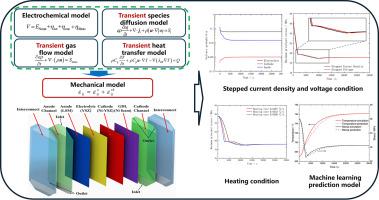动态加载条件下电解质支撑的平面固体氧化物电解池的瞬态热力学响应
IF 9.6
Q1 COMPUTER SCIENCE, ARTIFICIAL INTELLIGENCE
引用次数: 0
摘要
固体氧化物电解电池(soec)具有高效率、无贵金属结构和广泛的功率适应性,使其具有与可再生能源相结合的大规模绿色制氢的前景。然而,可再生能源的间歇性会引起电池温度和电化学场的时空梯度,从而导致应力集中和潜在的机械故障。因此,了解SOEC动态加载过程中的瞬态热力学响应对于评估电化学性能和预测电池寿命至关重要。以往的研究主要集中在建立稳态模型来研究电池中的热应力,而我们开发了一个瞬态多物理场模型来捕捉电解质支撑的平面SOEC在动态操作条件下的热-电-化学-力学耦合行为。数值模拟进行了不同的功率控制策略,加热速率和水蒸气摩尔分数。结果表明,电解液层始终具有最高的平均最大主应力和失效风险。阶梯式电流密度控制比阶梯式电压控制产生更高的升温速率和热应力。此外,较慢的水摩尔分数下降会降低电化学反应和吸热速率,从而导致较慢的温度上升和降低热应力。为了能够快速准确地预测临界热力学响应,使用气体进口加热速率作为输入,在模拟数据上训练随机森林回归模型。该模型准确地预测了电解质层中的温度和应力,并在未知情况下表现出很强的泛化能力。基于物理的高保真建模和机器学习的集成为智能SOEC控制和实时优化提供了基础,提高了系统可靠性,延长了可再生能源运行下的运行寿命。本文章由计算机程序翻译,如有差异,请以英文原文为准。

Transient thermomechanical response of an electrolyte supported planar solid oxide electrolysis cell under dynamic loading conditions
Solid oxide electrolysis cells (SOECs) offer high efficiency, noble-metal-free construction, and broad power adaptability, making them promising for large-scale green hydrogen production integrated with renewable energy. However, the intermittency of renewable energy induces spatial and temporal gradients in temperature and electrochemical fields of the cell, leading to stress concentrations and potential mechanical failure. Understanding the transient thermomechanical response during dynamic loading of a SOEC is thus crucial for evaluating the electrochemical performance and predicting cell lifetime. While previous studies focused on developing steady-state models to investigate the thermal stress in the cell, we develop a transient multi-physics model to capture the coupled thermo–electro–chemo–mechanical behavior of an electrolyte-supported planar SOEC under dynamic operating conditions. Numerical simulations are performed with varying power control strategies, heating rates and water vapor molar fractions. Results reveal that the electrolyte layer consistently experiences the highest average maximum principal stress and failure risk. Stepped current density control induces a higher heating rate and thermal stress compared to stepped voltage control. Additionally, a slower water molar fraction decline reduces electrochemical reaction and heat absorption rates, leading to a slower temperature rise and reduced thermal stress. To enable rapid and accurate prediction of critical thermomechanical responses, a Random Forest Regression model is trained on simulation data using gas inlet heating rate as input. The model accurately predicts temperature and stress in the electrolyte layer and demonstrates strong generalization on unseen scenarios. The integration of high-fidelity physics-based modeling and machine learning provides a foundation for intelligent SOEC control and real-time optimization, enhancing system reliability and extending operational lifetime under renewable energy operation.
求助全文
通过发布文献求助,成功后即可免费获取论文全文。
去求助
来源期刊

Energy and AI
Engineering-Engineering (miscellaneous)
CiteScore
16.50
自引率
0.00%
发文量
64
审稿时长
56 days
 求助内容:
求助内容: 应助结果提醒方式:
应助结果提醒方式:


